Jiangxi King Powder New Material Co., Ltd. Official
Search:Boron Nitride | Silica | Titanium Dioxide | Carbon Black Pre-Dispersion | Hydrophilic Pigment
Jiangxi King Powder New Material Co., Ltd. Official
Search:Boron Nitride | Silica | Titanium Dioxide | Carbon Black Pre-Dispersion | Hydrophilic Pigment
Simple Analysis the Influence Factors of Titanium Dioxide on Film Gloss
Wang Ling, Wang Zhen, Luo Jiao, Guo Ye
(Zhenjiang Inter-China Testing & Technology Co., Ltd., Jiangsu 212000,China)
Reproduced from https://www.ibuychem.com/expert/article/2492751
Abstract: titanium dioxide is considered to be the world’s best performance of a white pigment, widely used in coatings, plastics, paper, printing inks, chemical fiber, rubber, chemical, cosmetics and other industries. Coating industry is the largest user of titanium dioxide, especially rutile titanium dioxide, most are consumed by the coating industry. Coating gloss (except for special requirements) is an important indicator of coating performance. In this paper, from the particle size, surface treatment, dispersibility, oil absorption, pigment volume concentration (PVC) and other aspects, simple analysis the influence of the gloss coating, these influence factors have important meanings to the production of titanium dioxide and coating formulation design.
Key word: titanium dioxide; particle size; surface treatment; oil absorption; film gloss
0 Introduction
Coating, which is traditionally called "paint" in China, is a kind of material that can be applied on the surface of objects by different construction processes . It can form solid films with firm adhesion, certain strength and continuity, which is also called film, paint film or coat (Editorial Board of Coating Technology[EBCT], 1997, P. 1).
Reflection occurs when light strikes the surface of an object and this light reflection ability of the object surface is called gloss. The gloss of different object surfaces is different. And glossiness is to measure the light reflection ability of object surfaces. The higher the surface gloss of an object, the stronger its light reflection ability. There are many factors that affect the gloss of coating film, such as resin, pigment and filler, dispersant, ratio of pigment to resin in paint, substrate, color of coating film, and surface smoothness. Pigment is one of the components of coating. The pigment itself has no gloss, but the pigment features determines the gloss of the film (Deng & Wu, 2005, PP. 27-28). Titanium dioxide is an important pigment in coatings. Its particle size, surface treatment, dispersibility, oil absorption and the number of additives (pigment volume concentration, PVC) in coatings have certain influence on the gloss of coating films.
1 Experimental Part
1.1 Major Materials
Alkyd varnish (C01-1): Industrial grade, Changzhou Guanghui Chemical.
Acrylic resin (LP64/12N): Industrial grade, Evonik.
General additives for coating (diluents) are all industrial products in the market.
1.2 Experimental Instrument
Automatic mixer (RH-1): Zhengzhou Sanhua.
Automatic coating machine (PTA-2101): BYK Chemie.
Glossmeter (BYK4446): BYK Chemie.
High speed disperser (SFJ-400): Shanghai Xiandai.
Laser particle size analyzer (Bettersize3000): Bettersize.
Scraper fineness meter: Shanghai Xiandai.
Film applicator: groove depth is 150, Shanghai Xiandai.
1.3 Experimental Method
Weigh the same quality of glass drops, acrylic resin solution (solid content 26%) and titanium dioxide samples (pigment volume concentration PVC: 16%) , and put them into the automatic mixing machine for dispersion. Then place the dispersed paint on the automatic coating machine, scraping the paint on the mirror glass plate with a film applicator at a fixed pressure under a speed of about 100 mm/s to form a smooth film. After drying for 16 hours at (23 ± 2) ℃ and (50 ± 5)% relative humidity, the glossiness was measured. The test basis is GB / T 9754-2007 Paints and varnishes—Determination of specular gloss of non-metallic paint films at 20° 60°and 85°. (as listed here, subsequent tests shall be used to)
2 Results and Discussion
2.1 Influence of Titanium Dioxide Particle Size on The Gloss of Film
After testing different particle size of titanium dioxide by laser particle sizer, the corresponding film gloss was tested according to the experimental method 1.3. Please see Table 1 for the measurement results of film gloss and pigment particle size distribution.
Table 1 Particle size and film gloss of titanium dioxide

According to the measurement results in Table 1, the content of particles above 0.5μm has a great influence on the gloss of the film. The possible aggregation of particles below 0.2μm (small particles) when forming film should also be noticed, which will cause micro concave convex on film and reduce the gloss. Please see Figure 1.
Figure 1 Relationship between particle size distribution of titanium dioxide and film
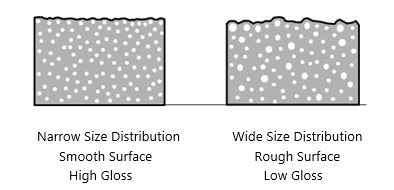
2.2 The Effect of Surface Treatment on The Gloss of Film
Surface treatment is the core part of titanium dioxide post-treatment process, also known as coating of titanium dioxide. Its purpose is to improve the application performance of titanium dioxide, so that it has excellent using effects in different applications. The coating can be divided into inorganic coating and organic coating according to the properties of the surface coating materials of titanium dioxide. Different coating materials have different effects on the gloss. Titanium dioxide with different surface treatment is selected for testing the coating gloss according to 1.3 test method, and the test results are shown in Table 2.
Table 2 Different surface treatment and film gloss
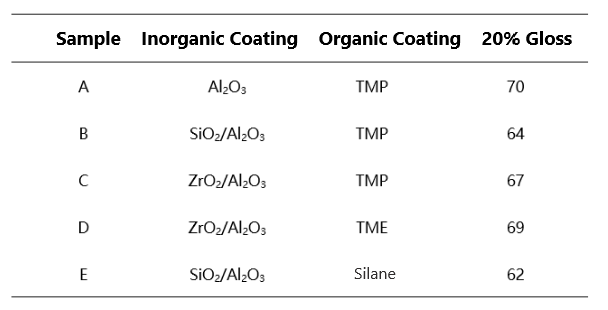
It can be seen from table 2 that the gloss of the paint film will be different with different coated titanium dioxide. At present, the domestic technology of dense silicon coating is not mature, so the gloss of silicon aluminum coating products is lower than that of zirconium aluminum products.
The surface of particles is insufficiently compact, homogeneous, or porous enough, resulting in the film is not smooth enough to generate extinction effect to reduce the gloss of the coating. At the same time, the gloss of product treated with TME as organic treatment agent is better than that of products treated with TMP and silane. For titanium dioxide production enterprises, they should also pay attention to the soluble impurities such as Na +, Cl -, SO42 - after surface treatment, which will affect the dispersibility and dispersion stability.
2.3 Effect of Oil Absorption on The Gloss of Film
The oil absorption of pigment refers to the minimum grams of oil needed to completely wet 100g titanium dioxide, that is, the amount of oil used to just bond pigment and oil into a ball. In general, pigment particles are fine with large specific surface area, so they will agglomerate and flocculate and the gap between them will be large, and then their oil absorption will be high, while oil absorption will be low if particles are nearly spherical. For solvent based coatings, titanium dioxide with high oil absorption is mixed, ground and dispersed in the solvent based coatings according to the original formula. A part of solvent oil is absorbed by titanium dioxide, which makes the oil for dissolving resin insufficient, so the solvation of resin is reduced, which affects the adsorption of titanium dioxide on resin, leading to the decrease of dispersibility and dispersion stability. At the same time, the viscosity of the system increases, so the leveling performance of the film becomes poor, which affects the smoothness of the film surface, thus reducing the gloss of the film. With products of similar surface treatment process but different oil absorption, the paint film was made according to the method in 1.3. The following are the experimental results, as shown in Figure 2.
Figure 2 Relation between oil absorption and gloss
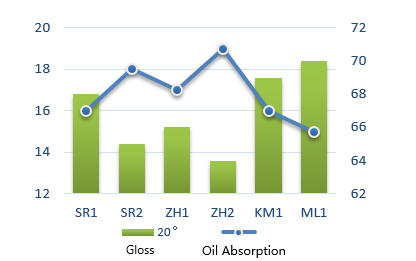
From Figure 2, titanium dioxide has a high oil absorption, and the film gloss is relatively low in solvent based coatings. The oil absorption affects the smoothness of the film surface, resulting in a decrease in gloss.
2.4 Effect of Pigment Dispersion on The Gloss of Film
The gloss of film is closely related to the roughness of film surface. When light hits the film surface, some will be absorbed by the film, some will be reflected and scattered, and some will be refracted. The smoother the film surface is, the more light it reflects, the higher the gloss; otherwise, the lower the gloss. Titanium dioxide powder without many coarse particles can be better and more evenly dispersed in the system, and makes it easy to form a smooth and complete film, which has a higher gloss. Please look at Figure 3 (Deng & Wu, 2005, pp. 27-28).
Figure 3 Dispersion degree and pigment characteristics of titanium dioxide
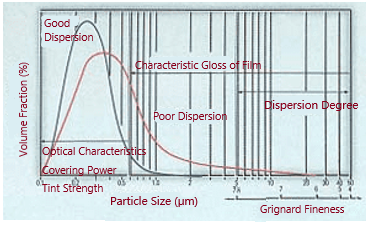
The dispersibility was determined in accordance with GB / T 21868.3-2008, Pigment and Extender Pigment, Dispersion Method for Evaluation of Dispersity, Part 3: Dispersion with High-Speed Mixer. Alkyd varnish (solid content: 40%) is used in the dispersion process. The shear speed of high-speed disperser is 10.5m/s, and the high-speed dispersion time is 10min. Before high-speed dispersion, the viscosity of alkyd varnish shall be adjusted to be the same or similar, so as to ensure the same shear force for high-speed dispersion. The test results are shown in Figure 4.
Figure 4 Relationship between dispersion fineness and glossiness
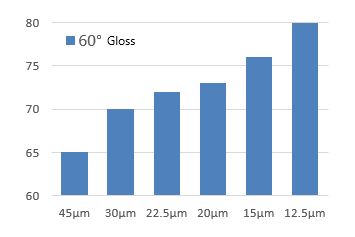
According to the test results in Figure 4, the film with low dispersion fineness has relatively high gloss. The more undispersed particles, the easier to form a rough coating layer, thus reducing the gloss of film.
2.5 Effect of Pigment Volume Concentration (PVC) on Gloss
Generally, with the increase of PVC, the specular gloss of titanium dioxide film tends to decrease. Please look at acrylic paint as shown in Figure 5. When PVC is 10%, there are 12 μ m defects in the film, but the density is low and the gloss is high; with the rise of PVC as shown in Figure 6, the defect size becomes smaller, the density increases and the gloss drops sharply.
Figure 5 Relationship between PVC and gloss of acrylic paint
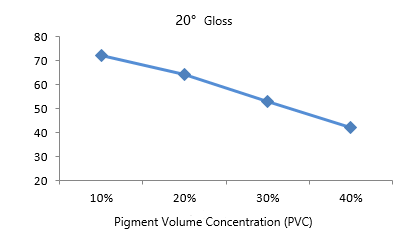
Figure 6 Surface micro defects generation model
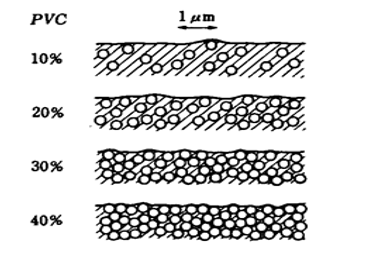
It can be concluded from above results that with the continuous increase of PVC, the surface roughness of film will also be increased. At the same time, the convection, which is between the lower and the upper layer caused by the solvent volatilization in film formation process, makes the pigment move in the film, causing the uneven distribution of the pigment in the film and the sharp decrease of the film gloss (Jiang, 2000, pp. 47-49).
3 Conclusion
(1) Titanium dioxide has less content of coarse particles whose particle size is more than 0.5 μ m and small particles whose particle size is less than 0.2 μ m, and its particle size distribution is relatively concentrated, which is conducive to improving the gloss of film.
(2) The density of surface coating on particle can enhance the gloss of film. Due to the limitation of dense silica coating technology in China, the gloss of zirconium aluminum coating products is better than that of silica aluminum coating products, and the gloss of TME treated products is slightly better than that of TMP and silanes treated products. At the same time, titanium dioxide manufacturers should control the content of soluble impurities such as Na +, Cl -, SO42 – generated from surface treatment.
(3) The high oil absorption of titanium dioxide will lead to the decrease of dispersibility and dispersion stability, the increase of system viscosity and the decrease of leveling performance of film, and then decrease the gloss of film for the above influence on flatness.
(4) The particle distribution of titanium dioxide is relatively concentrated and there are not many coarse particles, so it can be better and more evenly dispersed in the system, forming a relatively smooth and complete coating with high gloss.
(5) On the premise of meeting film performance (covering, whiteness and other mechanical properties), the gloss of film can be improved by properly reducing PVC.
In summary, the influencing factors of titanium dioxide need to be considered for getting a high gloss film, whether in production or formulation design of paint. However, titanium dioxide is only one of the components of paint. To get a good film gloss, when designing the formulation of paint, factors such as resin, dispersant, pigment ratio and substrate should be taken into account, and a best balance between them should be found.
References:
Deng J., & Wu L. F. (2005). Application Manual of Titanium Dioxide. Beijing: Chemical Industry Press. pp. 27-28
Editorial Board of Coating Technology (1997). Coating Technology. (3rd ed.). Beijing: Chemical Industry Press. p. 1
Jiang W. T. (2000). Pigment Volume Concentration and Film Properties. Shanghai Coating Journal, 38(2), 47-49
Recommendation:
King Powder provides high-performance Titanium Dioxide, a selected rutile type with high gloss, high covering power and high weather resistance. The particle size is concentrated in 0.3 to 0.4 μm. The surface is densely coated by zirconium aluminum, with less soluble impurity ion and low oil absorption.
After special hydrophilic / lipophilic surface modification from King Powder, the dispersibility of Titanium Dioxide in water / oil is greatly improved, and a very good film gloss can be obtained in the application of paint / ink.